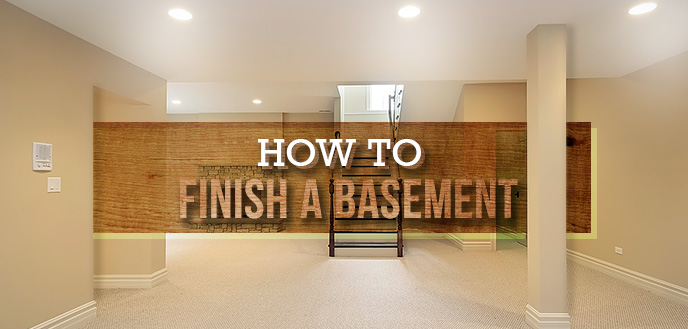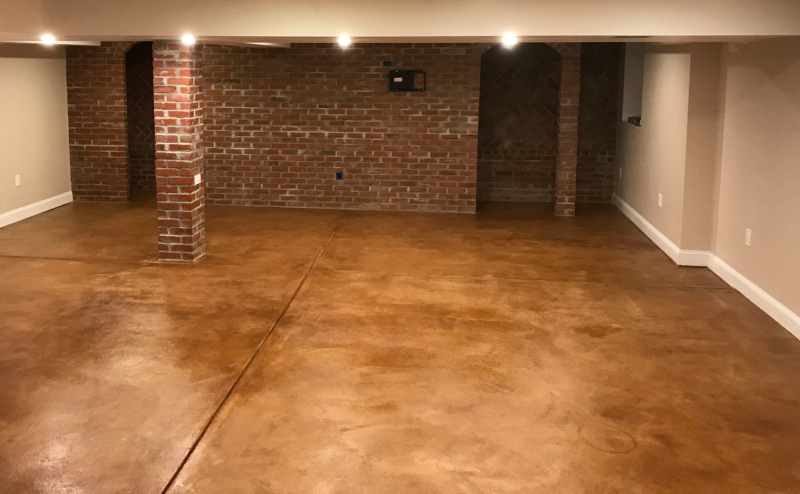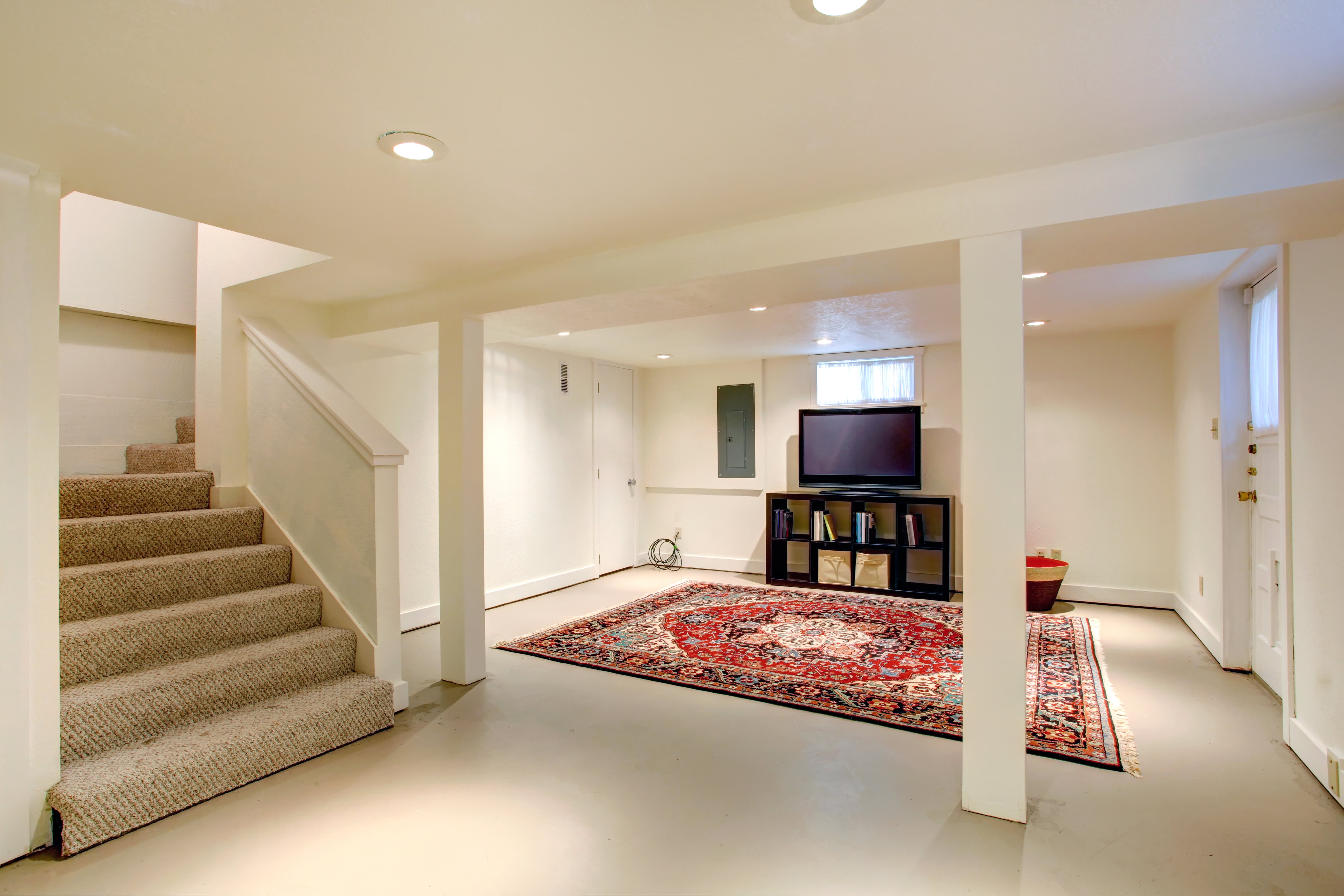Why Redoing Your Basement Floor is Worth the Investment
Redoing your basement floor might seem unnecessary at first, but the long-term benefits are well worth it. Whether trying to add value to your home, create a more functional space, or address moisture issues, upgrading your basement floor is a smart investment. Below are the reasons why it’s worth every penny.
- Increase Home Value: A finished basement adds value to your home, and the flooring is a crucial part of that. Homebuyers often see a finished basement as additional living space, which can increase the marketability and value of your home. Investing in a durable, visually appealing floor makes the space feel complete, providing a higher return on investment when it’s time to sell.
- Enhance the Aesthetic Appeal: Redoing your basement floor can significantly improve the overall aesthetic of the space. Whether you’re going for a modern, industrial look with polished concrete or a cozy, homey vibe with vinyl planks, the right flooring can transform a drab basement into a stylish extension of your living area.
- Address and Prevent Moisture Issues: Basements are notorious for moisture problems, and a new floor can help address or prevent those issues. Choosing moisture-resistant materials like epoxy or vinyl can protect against water damage and mold growth. Plus, prepping the floor properly can solve existing issues like cracks or uneven surfaces that let moisture seep in.
- Improve Durability and Longevity: The basement floor sees a lot of wear and tear, whether it’s from foot traffic, heavy storage, or even gym equipment. Redoing the floor with durable materials like concrete or tile can withstand all of that and more, ensuring that the space remains functional for years to come without the need for constant repairs.
- Increase Usable Space: If your basement floor is uneven, cracked, or simply uninviting, you’re likely not using the space to its full potential. By redoing the floor, you can convert it into a usable area for anything from a family room to a home office. The right flooring can make it feel like a true extension of your home, rather than an afterthought.
- Better Energy Efficiency: A proper floor redo can also improve your home’s energy efficiency. Insulated flooring options help maintain a consistent temperature in the basement, reducing the need for additional heating or cooling. This not only makes the basement more comfortable but can also lower your overall energy bills.

Signs It’s Time to Replace or Redo Your Basement Floor
Your basement floor might be telling you it’s time for an upgrade, but are you paying attention? Often, the signs of a deteriorating floor are easy to miss. If you’re noticing any of these red flags, it’s probably time to consider redoing your basement floor.
Cracks and Uneven Surfaces
Cracks in the basement floor are a major sign that it’s time for a redo. While small hairline cracks might seem harmless, larger cracks can indicate structural issues or shifting foundations. Uneven surfaces are not only unsightly but can also become tripping hazards, especially in high-traffic areas.
Persistent Moisture or Water Damage
If you notice damp spots, musty odors, or visible water damage, these are clear indicators that the basement floor needs attention. Water damage not only weakens the floor over time but can also lead to mold growth and unhealthy living conditions.
Outdated or Worn Materials
Old, worn-out flooring materials like outdated linoleum or cracked tiles not only detract from the aesthetic of your basement but also indicate that the floor has seen better days. If your basement floor feels like a blast from the past in all the wrong ways, it’s time for an update.
Cold and Uncomfortable Floors
Basement floors that feel excessively cold or uncomfortable underfoot could benefit from a redo with materials that offer better insulation. This can help create a cozier atmosphere, especially if you plan on using the basement as a living or recreational space.
Difficulty Cleaning or Maintaining the Floor
If your basement floor is becoming increasingly difficult to clean or maintain, it’s probably due for a replacement. Materials like old carpeting or cracked tiles can trap dirt and moisture, making them a hassle to clean and potentially harboring mold or bacteria.
Peeling Paint or Surface Finishes
If your painted or finished floor is peeling, chipping, or wearing away, it’s a sign that the surface is no longer protecting the underlying material. This can lead to further deterioration and should be addressed sooner rather than later.
Choosing the Best Flooring Material for Your Basement
Choosing the right flooring material for your basement is key to ensuring durability, moisture resistance, and aesthetic appeal. Not all flooring types work well in basements due to the specific environmental conditions, so it’s essential to choose wisely. Let’s explore some of the best options.
Vinyl Flooring
Vinyl is one of the most popular choices for basement floors due to its water resistance, affordability, and wide variety of designs. It mimics the look of hardwood or tile, without the susceptibility to moisture damage. Plus, it’s soft underfoot, making it a comfortable option for finished basements.
Epoxy Coatings
Epoxy is an excellent option if you’re looking for something durable and low-maintenance. It creates a sleek, glossy finish that’s highly resistant to moisture, stains, and wear. However, it can be a bit tricky to install if you’re going the DIY route, as the surface needs to be perfectly prepped.
Polished Concrete
If you’re after an industrial or minimalist look, polished concrete is a fantastic choice. It’s durable, easy to clean, and can be finished with various stains or colors. While it’s one of the more affordable options, it can be cold underfoot, so it may not be the best choice if comfort is a priority.
Engineered Wood
If you love the look of hardwood but worry about moisture, engineered wood is a great compromise. It’s more stable than solid hardwood and can withstand the humidity and temperature fluctuations common in basements. However, it’s not completely waterproof, so moisture control is still essential.
Ceramic or Porcelain Tile
Tile is a classic choice for basement floors due to its durability and water resistance. It’s easy to clean and comes in a wide range of styles. However, like polished concrete, it can be cold underfoot, so it’s often best used with an area rug or radiant heating.
Rubber Flooring
If you’re planning to use your basement as a gym or play area, rubber flooring is a fantastic option. It’s durable, shock-absorbent, and easy to clean. Plus, it adds an extra layer of insulation, making the space more comfortable.
Prepping Your Basement for a Floor Redo: Essential Steps
Before diving into the exciting part of laying new flooring, prepping your basement is crucial for a successful floor redo. Proper preparation ensures that your new floor will last longer, be more durable, and look great. Skipping this stage can lead to problems down the line, such as moisture issues or uneven surfaces. Let’s walk through the essential steps you’ll need to take before starting the project.
Clear the Space and Remove Old Flooring
The first step in prepping your basement is to clear out the entire area. Remove any furniture, boxes, or clutter that might get in the way. Once the space is cleared, you’ll need to remove the existing flooring. Whether you’re dealing with old carpet, linoleum, or tiles, getting rid of the old materials ensures a smooth start for your new floor. Be prepared to spend some time on this, as it might require specialized tools or professional help, depending on the material.
Inspect for Cracks and Structural Issues
Once the old flooring is out of the way, inspect the surface for any visible cracks or structural issues. Small cracks might not seem like a big deal, but they can let moisture in and cause bigger problems over time. If you notice significant cracks or uneven surfaces, you’ll want to address them before proceeding. This may involve using a concrete filler or hiring a contractor to assess the foundation for potential repairs.
Address Moisture Problems
One of the most important steps in prepping your basement is dealing with any moisture problems. Basements are notorious for being damp, which can ruin your new floor if not addressed. Check for any signs of water damage, mold, or excessive humidity. Installing a moisture barrier or using a dehumidifier can help. For more severe issues, you might need to seal the floor with a waterproofing product or install a sump pump to prevent future flooding.
Level the Floor
A level surface is essential for any type of flooring installation. Uneven floors can cause tiles to crack or vinyl planks to shift over time. Use a level tool to check for uneven spots. If your floor is sloped or has dips and humps, you’ll need to use a self-leveling compound to even it out. This step can be a bit tricky, so take your time to ensure the surface is as smooth and level as possible.
Clean the Surface Thoroughly
Before you start laying down new flooring, it’s essential to thoroughly clean the surface. Any dust, dirt, or debris left on the floor can interfere with the adhesive or cause bumps under your new material. Use a shop vacuum to remove debris, followed by a damp mop to ensure the surface is clean and ready for installation. Be sure to allow the surface to dry completely before moving on.
Apply a Primer or Underlayment (If Needed)
Depending on the type of flooring you’ve chosen, you may need to apply a primer or underlayment. For example, if you’re installing vinyl planks, you might need a foam underlayment to create a cushion and sound barrier. For concrete floors, a primer can help with adhesion and improve the durability of the topcoat. Follow the manufacturer’s recommendations for your chosen flooring material to ensure the best results.
DIY vs. Hiring a Professional for Redoing Your Basement Floor
When it comes to redoing your basement floor, one of the biggest decisions you’ll face is whether to tackle the project yourself or hire a professional. Both options have their advantages and drawbacks, depending on your skill level, budget, and the complexity of the job. Let’s break down the pros and cons of each approach to help you make the best choice for your project.
Cost Considerations
DIY is often the go-to choice for homeowners looking to save money. By doing the work yourself, you can avoid labor costs, which can make up a significant portion of the total expense. However, keep in mind that mistakes or improper installation can lead to costly repairs later on. Hiring a professional may seem more expensive upfront, but it can save you money in the long run by ensuring the job is done correctly the first time.
Skill Level and Tools
Before deciding to take on the project yourself, consider your own skill level and the tools required for the job. Installing certain types of flooring, like tiles or epoxy, can be challenging if you don’t have prior experience. You’ll also need to invest in or rent tools, which can add to the overall cost. On the other hand, professionals come equipped with the necessary tools and expertise, ensuring a smoother installation process.
Time Commitment
Redoing a basement floor can be a time-consuming project, especially if you’re doing it yourself. Between prepping the area, installing the flooring, and making sure everything is done right, you could easily spend several weekends on the job. If you have a busy schedule, hiring a professional might be the better option since they can typically complete the project in a fraction of the time.
Quality of Work
The quality of your floor redo will largely depend on who’s doing the work. If you’re confident in your DIY skills, you might be able to achieve professional-quality results. However, mistakes can be costly, both in terms of money and time. Professionals bring years of experience to the table and are more likely to deliver high-quality results that last for years to come.
Warranty and Guarantees
One big advantage of hiring a professional is that most contractors offer warranties or guarantees on their work. This gives you peace of mind that if something goes wrong, they’ll come back and fix it at no additional cost. With DIY, you’re on your own if something doesn’t go as planned. Having that extra security might be worth the added expense of hiring a pro.
Personal Satisfaction
For many homeowners, the satisfaction of completing a DIY project is a major motivator. If you enjoy working with your hands and take pride in improving your home, redoing your basement floor yourself can be incredibly rewarding. Just be sure to weigh this personal satisfaction against the potential risks and challenges of tackling the job on your own.
Cost Breakdown: How Much Does It Cost to Redo a Basement Floor?
When planning a basement floor redo, understanding the costs involved is essential to creating a budget that works for you. Several factors will impact the total cost, from the type of flooring you choose to whether you go the DIY route or hire a professional. Let’s break down the key expenses you should be prepared for.
Flooring Material Costs
The type of flooring you choose will be one of the biggest factors in your overall cost. Vinyl planks and laminate are some of the more affordable options, ranging from $2 to $5 per square foot. On the other hand, higher-end options like polished concrete or engineered wood can cost upwards of $7 to $15 per square foot. Keep in mind that the cost of materials will vary depending on the quality and brand.
Labor Costs
If you decide to hire a professional, labor costs will significantly impact your budget. On average, you can expect to pay between $3 to $8 per square foot for professional installation, depending on the complexity of the job and your location. Some types of flooring, like epoxy or tile, may require specialized labor, which could increase the overall cost.
Tools and Equipment
For those taking the DIY approach, tools and equipment can add to the overall expense. Depending on the flooring material, you might need to rent tools like floor sanders, tile cutters, or mixing drills. The cost of these rentals can add up quickly, ranging from $50 to $150 per day. You’ll also need to factor in consumables like adhesive, grout, or underlayment.
Subfloor and Underlayment
In some cases, you may need to install a subfloor or underlayment, which adds to the cost. For example, if your basement floor is uneven or has moisture issues, you might need to invest in a self-leveling compound, moisture barrier, or foam underlayment. These materials can cost anywhere from $0.50 to $3 per square foot, depending on the specific needs of your basement.
Additional Materials and Supplies
Other materials, such as adhesives, grout, and sealants, will also add to your total cost. Be sure to factor in these extras when budgeting for your project. Depending on the size of your basement and the type of flooring you’re installing, these materials can range from $100 to $500 or more.
Unexpected Expenses
It’s always a good idea to build a buffer into your budget for unexpected expenses. Issues like moisture damage, foundation problems, or the need for additional prep work can quickly increase the cost of your project. Aim to set aside at least 10-15% of your total budget for unforeseen complications.
Maintenance Tips for Your Newly Redone Basement Floor
Once you’ve finished redoing your basement floor, keeping it in great condition is key to ensuring it lasts for years to come. Proper maintenance not only extends the life of your floor but also helps it maintain its aesthetic appeal. Here are some practical tips for caring for your newly redone basement floor.
Regular Cleaning
No matter what type of flooring you’ve installed, regular cleaning is essential. For vinyl, laminate, or tile floors, sweeping or vacuuming at least once a week will help remove dust and dirt. For polished concrete or epoxy floors, use a damp mop to keep the surface clean without damaging the finish. Be sure to avoid harsh chemicals that could degrade the material over time.
Address Spills and Moisture Immediately
Basements are prone to moisture, and any spills should be addressed immediately to avoid water damage. For water-resistant floors like vinyl or tile, wiping up spills quickly will prevent stains and ensure the floor remains in top shape. For wood-based floors, addressing moisture is even more critical, as it can warp or damage the material over time.
Use Area Rugs for Extra Protection
If you’re concerned about wear and tear in high-traffic areas, consider using area rugs to protect your new floor. Rugs add an extra layer of protection and prevent scratches or dents from furniture. Just be sure to choose rugs with a non-slip backing to avoid accidents.
Avoid Heavy Impact
Be mindful of heavy items on your new basement floor. While some materials like epoxy or tile are durable, they can still crack or dent if subjected to heavy impact. Use furniture pads to protect the floor from scratches or gouges caused by moving heavy furniture.
Maintain Proper Humidity Levels
Basements tend to be more humid than other areas of the home, which can cause issues with certain flooring materials. Use a dehumidifier to maintain proper humidity levels, especially if you’ve installed wood-based flooring. Keeping the humidity between 30-50% will prevent warping, swelling, or mold growth.
Perform Annual Inspections
Once a year, perform a thorough inspection of your basement floor to catch any potential issues early. Look for signs of wear, moisture damage, or structural problems. Addressing these issues promptly will save you time and money in the long run by preventing more extensive damage.
Best Basement Flooring Options 2024
Aesthetic Basement Floor ideas flooring, stained concrete
Basement Layout Mistakes
Related Posts:




.jpg?widthu003d800u0026nameu003d11513489635_f12521f2a2_k%20(1).jpg)



